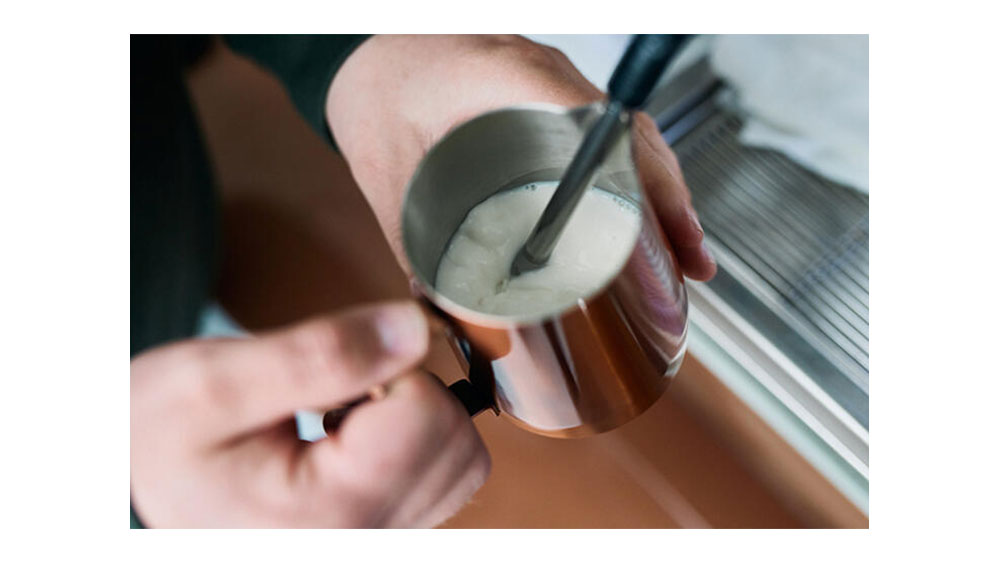Steaming milk is something that every coffee lover that frequents a café is familiar with. The sleek milk wand on every espresso machine is there for a specific purpose – to pump hot water vapor (steam) into the milk for our more complicated coffee beverages. So what is steaming milk all about?
First, let’s take a step back, this is seem a little odd. Steaming certainly not the easiest or cheapest way to heat up milk, so why do we do it? Well, in this post, we’re going to answer that question, and fill you in on some fun facts about steaming milk for your favorite coffee drink.
What does steaming milk do?
Well, the first answer to this question is the obvious one – to get the milk hot. This makes a lot of sense, of course, and it indicates the clearest answer to the question – a latte would be awfully strange with cold milk and hot espresso.
To understand why, here’s a side note about coffee chemistry: Adding cold milk directly to an espresso would drastically change the coffee’s fundamental properties. That’s because espresso is basically a chemical solution. It’s made by dissolving coffee oils and other solids into water at an extremely high pressure and temperature. Cooling it down suddenly with cold milk makes the dissolved coffee solids come out of the solution. This can change the taste, texture, and consistency of your espresso. This is also why professional baristas warm up their coffee mugs before pulling espresso shots into them. That’s it for your chemistry interlude: back to steaming milk.
Steam is also used for the texture that it can give milk, too. A good steam wand will fire steam into a pitcher at such a rate that it can generate bubbles in the liquid within the pitcher. This increases the volume of the milk over time, and introduces small, hot bubbles of air into the milk itself, heating it evenly and efficiently.
So, on a basic level, the answer to the question is simple – we steam milk to heat it and improve its texture. However, what does the steam really do to the milk? To answer that question, we need to quickly run through what’s actually in a glass of milk.
What’s in milk, really?
The best way to help you think about the makeup of milk is to consider what it exists for – it’s a product of evolution designed to bring about fast growth in young cows. It has a lot of fat and sugar in it, which leads to a high-calorie density – this kind of nutrition is normal in food for babies.
The vast majority of a pint of milk is water, which makes a lot of sense. A calf is unlikely to drink from a trough of water, so it gets most of its water from milk.
After the water content, the next largest piece of milk is sugar in the form of lactose. This makes up just under five percent of the volume of a pint of milk. Sugar is considered somewhat of an immediate energy boost.
The remaining content of the milk is split fairly event between proteins and fat. Proteins would be used by a calf to build muscle mass, and that’s the same thing humans use those chemicals for. Fat would be used as a long-term energy source, since it can be stored in the cells of an animal for a long time.
The protein and fats in milk are the things responsible for creating the foam that we see when we steam milk. They provides something of a support structure that air bubbles can exist within.
What does steaming do to milk?
So, with the protein of the milk working as a type of scaffold for bubbles, what actually happens when you pump steam into the mixture.
When you turn on a steam wand, steam is, obviously, forced out of the wand itself. Jets of it break the surface tension of the milk and rapidly force air into the liquid. If the tip is too high, large bubbles will be introduced to the surface of the milk. If it’s too low, the milk will be warmed, but the surface tension won’t be broken, disallowing bubbles.
With the wand positioned correctly, steam is forced into the milk, and the air is trapped within protein molecules, leading to microfoam being constructed within the beverage.
These bubbles of steam are, of course, hot. This heat is conducted through the body of the milk, with the bubbles trapped within protein being bounced around by the propelling force of the steam itself.
This stirring motion also serves to incorporate the foam well, mixing it evenly throughout the body of the drink itself. This ensures that the entire volume of the milk contains microfoam, rather than just a small portion of it.
Finally, we want to have a quick word on the carbohydrate content of the milk. The lactose within the milk, while a sugar, is technically a carbohydrate. This means that as the heat of the steam is applied to it, it breaks down into simpler carbohydrates, which are sweet.
For this reason, you can apply heat or pressure to different carbohydrates, and they’ll become sweet. For example, raw potato isn’t sweet at all, but it typically becomes sweet after being roasted or baked for a long time.
How fat content affects milk foam
This is a worthwhile tidbit that you need a little bit of chemistry knowledge. The protein molecules in milk have a hydrophobic section and a hydrophilic section. If something’s hydrophobic, it’s water repellent. If something’s hydrophilic, it readily bonds to water.
We mention this because the hydrophobic portion of protein molecules will just as rapidly bond with air as it will with fat in milk. This means that the more fat there is in milk, the less air it will be able to hold. Therefore, high-fat milk will make less foamy milk.
It’s also important to say that due to the way our tastebuds developed over time, fat is inherently tasty to us. This means that while high-fat milk will have less foam, the foam may be tastier – it’s all a matter of perspective and considering whether you value texture or flavor more.
We hope this short article has been able to furnish you with the answers to some of your questions about steaming milk. It’s a complex topic, and it would be foolish to presume that we’ve got everything squared away here. Either way, we hope you’ve learned something, and we hope that all the milk you steam comes out wonderfully well!

